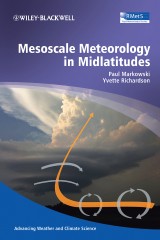Details

Mesoscale Meteorology in Midlatitudes
Advancing Weather and Climate Science 1. Aufl.
|
73,99 € |
|
| Verlag: | Wiley |
| Format: | |
| Veröffentl.: | 16.03.2010 |
| ISBN/EAN: | 9780470682098 |
| Sprache: | englisch |
| Anzahl Seiten: | 432 |
DRM-geschütztes eBook, Sie benötigen z.B. Adobe Digital Editions und eine Adobe ID zum Lesen.
Beschreibungen
<b>Mesoscale Meteorology in Mid-Latitudes</b> presents the dynamics of mesoscale meteorological phenomena in a highly accessible, student-friendly manner. The book's clear mathematical treatments are complemented by high-quality photographs and illustrations. Comprehensive coverage of subjects including boundary layer mesoscale phenomena, orographic phenomena and deep convection is brought together with the latest developments in the field to provide an invaluable resource for mesoscale meteorology students. <p> <b>Mesoscale Meteorology in Mid-Latitudes</b> functions as a comprehensive, easy-to-use undergraduate textbook while also providing a useful reference for graduate students, research scientists and weather industry professionals.</p> <ul type="disc"> <li>Illustrated in full colour throughout </li> <li>Covers the latest developments and research in the field </li> <li>Comprehensive coverage of deep convection and its initiation </li> <li>Uses real life examples of phenomena taken from broad geographical areas to demonstrate the practical aspects of the science </li> </ul>
<p>Series Foreward xi</p> <p>Preface xiii</p> <p>Acknowledgments xv</p> <p>List of Symbols xvii</p> <p><b>PART I General Principles 1</b></p> <p>1 What is the Mesoscale? 3</p> <p>1.1 Space and time scales 3</p> <p>1.2 Dynamical distinctions between the mesoscale and synoptic scale 5</p> <p>2 Basic Equations and Tools 11</p> <p>2.1 Thermodynamics 11</p> <p>2.2 Mass conservation 16</p> <p>2.3 Momentum equations 17</p> <p>2.4 Vorticity and circulation 21</p> <p>2.5 Pressure perturbations 25</p> <p>2.6 Thermodynamic diagrams 32</p> <p>2.7 Hodographs 34</p> <p>3 Mesoscale Instabilities 41</p> <p>3.1 Static instability 41</p> <p>3.2 Centrifugal instability 48</p> <p>3.3 Inertial instability 49</p> <p>3.4 Symmetric instability 53</p> <p>3.5 Shear instability 58</p> <p><b>PART II Lower Tropospheric Mesoscale Phenomena 71</b></p> <p>4 The Boundary Layer 73</p> <p>4.1 The nature of turbulent fluxes 73</p> <p>4.2 Surface energy budget 82</p> <p>4.3 Structure and evolution of the boundary layer 83</p> <p>4.4 Boundary layer convection 88</p> <p>4.5 Lake-effect convection 93</p> <p>4.6 Urban boundary layers 103</p> <p>4.7 The nocturnal low-level wind maximum 105</p> <p>5 Air Mass Boundaries 115</p> <p>5.1 Synoptic fronts 117</p> <p>5.2 Drylines 132</p> <p>5.3 Outflow boundaries 140</p> <p>5.4 Mesoscale boundaries originating from differential surface heating 149</p> <p>6 Mesoscale Gravity Waves 161</p> <p>6.1 Basic wave conventions 161</p> <p>6.2 Internal gravity wave dynamics 165</p> <p>6.3 Wave reflection 170</p> <p>6.4 Critical levels 172</p> <p>6.5 Structure and environments of ducted mesoscale gravity waves 173</p> <p>6.6 Bores 175</p> <p><b>PART III Deep Moist Convection 181</b></p> <p>7 Convection Initiation 183</p> <p>7.1 Requisites for convection initiation and the role of larger scales 183</p> <p>7.2 Mesoscale complexities of convection initiation 189</p> <p>7.3 Moisture convergence 195</p> <p>7.4 Elevated convection 197</p> <p>8 Organization of Isolated Convection 201</p> <p>8.1 Role of vertical wind shear 201</p> <p>8.2 Single-cell convection 206</p> <p>8.3 Multicellular convection 209</p> <p>8.4 Supercellular convection 213</p> <p>9 Mesoscale Convective Systems 245</p> <p>9.1 General characteristics 245</p> <p>9.2 Squall line structure 249</p> <p>9.3 Squall line maintenance 253</p> <p>9.4 Rear inflow and bow echoes 260</p> <p>9.5 Mesoscale convective complexes 265</p> <p>10 Hazards Associated with Deep Moist Convection 273</p> <p>10.1 Tornadoes 273</p> <p>10.2 Nontornadic, damaging straight-line winds 292</p> <p>10.3 Hailstorms 306</p> <p>10.4 Flash floods 309</p> <p><b>PART IV Orographic Mesoscale Phenomena 315</b></p> <p>11 Thermally Forced Winds in Mountainous Terrain 317</p> <p>11.1 Slope winds 317</p> <p>11.2 Valley winds 320</p> <p>12 Mountain Waves and Downslope Windstorms 327</p> <p>12.1 Internal gravity waves forced by two-dimensional terrain 327</p> <p>12.2 Gravity waves forced by isolated peaks 332</p> <p>12.3 Downslope windstorms 333</p> <p>12.4 Rotors 342</p> <p>13 Blocking of the Wind by Terrain 343</p> <p>13.1 Factors that govern whether air flows over or around a terrain obstacle 343</p> <p>13.2 Orographically trapped cold-air surges 346</p> <p>13.3 Lee vortices 351</p> <p>13.4 Gap flows 358</p> <p><b>PART V Appendix 367</b></p> <p>A Radar and Its Applications 369</p> <p>A.1 Radar basics 369</p> <p>A.2 Doppler radar principles 371</p> <p>A.3 Applications 374</p> <p>References 389</p> <p>Index 399</p>
<p>"In summary, I highly recommend this book for use in courses in mesoscale meteorology at the advanced undergraduate and graduate level. It will serve as an important reference for researchers, instructors, and practitioners, and I look forward to using it in even more depth in my future teaching." (<i>Bulletin of the American Met Society</i>, 2012)</p> <p>"Markowski and Richardson (both meteorology, Penn State U.) deliver a very accessible advanced text on the dynamics of mesoscale meteorological phenomena, including boundary layer mesoscale phenomena, orographic phenomena and deep convection . . . an eye-pleasing design and extensive use of color photographs and illustrations make this book especially usable as both an undergraduate text and as a reference for graduate students, researchers, and meteorologists." (<i>Booknews</i>, 1 April 2011)</p>
<p><b>Paul M. Markowski</b> is an American meteorologist and leading expert on tornadogenesis and the forecasting of supercells and tornadoes. He was a principal investigator for the IHOP, PAMREX, and VORTEX2 field projects and, with Joshua Wurman, Howard Bluestein, et al., was on the VORTEX2 Steering Committee.</p> <p><b>Yvette Richardson</b> is the author of <i>Mesoscale Meteorology in Midlatitudes</i>, published by Wiley.</p>
<i>Mesoscale Meteorology in Midlatitudes</i> presents the dynamics of mesoscale meteorological phenomena in a highly accessible, student-friendly manner. The book’s clear mathematical treatments are complimented by high-quality colour photographs and illustrations. Comprehensive coverage of subjects including boundary layer mesoscale phenomena, orographic phenomena and deep convection is brought together with the latest developments in the field to provide an invaluable resource for mesoscale meteorology students. <p><i>Mesoscale Meteorology in Midlatitudes</i> functions as a comprehensive, easy-to-use undergraduate textbook while also providing a useful reference for graduate students, research scientists and weather industry professionals.</p> <ul type="disc"> <li>Illustrated in full colour throughout</li> <li>Covers the latest developments and research in the field</li> <li>Comprehensive coverage of deep convection and its initiation</li> <li>Uses real-life examples of phenomena taken from broad geographical areas to demonstrate the practical aspects of the science</li> </ul>

















